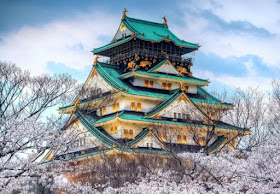The iconic castles seen today in many Japanese postcards have a history of their own to tell the world. Their architecture and structures changed, evolved and shaped to suit the needs of the time they were built; yet, they all had a common point–they were majestic and commanding.
 |
| Castle foundation |
 |
| Kin no Sachi, a castle roof decoration |
During the turbulent
Warring States period (1467–1568) the castles were constructed as fortresses to guard the feudal warlords and their retainers against the enemies. Built on top of mountains (
yamajiro) for defence purposes, they were surrounded by a moat and fourfold overlapping stone walls of height of 61 meters/200 feet. The section of the walls placed in front of the gates were angled to confuse the intruders. Should the trespassers overcome this obstacle, then sudden descents and switchbacks on the ground layout, stopped them from finding the entrance of the main keep. Should the entrance be found, however, some areas of the floors of the main keep were partitioned as a maze to trap the invaders. Furthermore, the use of technique of piling disordered stones (
ranseki-zumi) to build the foundation, not only added to its security, as it was very hard to climb them, but also allowed for flexibility and movement during an earthquake. These fortifications were considered impregnable.
 |
| Nagoya Castle Interior |
In the second half of the 16th century, the country was unified, and people lived more peaceful times. Unlike their predecessors, the new castles were built on flatlands (
hirajiro) or on small hills in the plains (
hirayamajiro), where they served as a region's administrative and military headquarters and a symbol of authority. Usually a small town called
jokamachi (castle town) formed around these structures, breeding a lively urban area of vassal dwellings, merchants and artisans.
Once achieving a pinnacle of 5,000, many castles were destroyed voluntarily or involuntarily along the history.
In 1615, the
Shogun issued a decree prohibiting the warlords to have more than one castle in their domains and many had to be destroyed.
 |
| The Osaka Castle |
After the
Meiji Restoration of 1868, the incoming government issued its own decree on removal of castles, and many more were crashed to the ground.
During the World War II, many were shattered and today, only a dozen original castles, survives.
Yet, several dozen castles were reconstructed over the past decades, bringing them back to their former glory.
The
Tokyo Imperial Palace, the official residence of the Imperial Family was the last dwelling of the
Shogun, who was deposed in 1868. The capital then moved from
Kyoto to
Edo, the city known today as Tokyo.
 |
| The Tokyo Imperial Palace |









